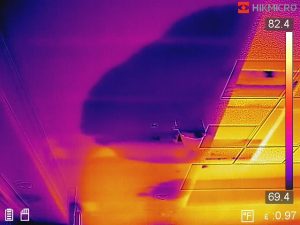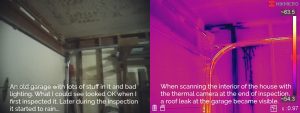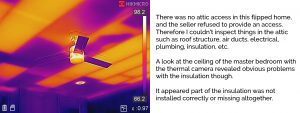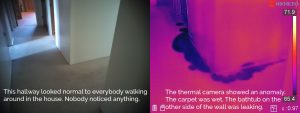What is thermography?
Thermography is a technology using a thermal or infrared (IR) camera to create an image of invisible infrared radiation emitted from an object. A thermal/IR camera does this by scanning a surface, measuring the temperatures, and displaying an image of the surface on a screen using a color spectrum to indicate relative temperature differences. Here is an example of an image taken with an IR camera:

Sounds complicated and geeky. Why should I care?
Thermography is a very useful tool when inspecting a home if used properly. It can detect thermal anomalies on surfaces that are not visible to the naked eye. A thermal anomaly is when the temperature of a surface is not what you expect it to be or what it should be under normal circumstances. The thermal anomaly could be a sign of an issue or defect that would otherwise elude observation.
Thermal anomalies can identify defects such as:
- Hidden leaks where drywall is damp due to moisture but the drywall is not damaged yet or visibly leaking.
- Hidden leaks where carpet is damp due to moisture but it is not visible when just looking at it or walking on it.
- Hidden insulation issues in walls or ceilings where heat makes it into or out of the house where it shouldn’t. This could be due to insulation not installed properly, insufficient amount of insulation, or insulation missing altogether.
- Electrical components overheating due to improper wiring or defective components
- Critters inside walls
All these issues are usually concealed or not visible with the naked eye. As a result, they are missed during a regular home inspection.
Interesting! Do you have some examples of what you’ve found?
Sure! Here are a few examples of hidden issues we often find. Click on the image for a larger version.

This first example shows rain water getting through the roof of the garage and running down the wall. It can be helpful when it rains before or during the inspection. If it had not rained for a few weeks before the inspection, or if we hadn’t scanned the home with the infrared camera at the end of the inspection, this issue might have remained unseen.

This second example shows insulation in an attic over a master bedroom either not properly installed or missing altogether. There was no attic access at the house, preventing us from inspecting the insulation in the attic. Without an infrared camera, this defect would have remained hidden.

This third example shows a typical two-story home with the master bathroom above the garage. The bathtub plumbing had a leak. The leak was not visible and the drywall looked completely normal to the naked eye. Without the infrared camera, the leak would have only appeared when it finally damaged the drywall enough and started leaking into the garage.
We had another two-story home with the upstairs master bathroom above the downstairs home office. The toilet was leaking right above the computer desk. With the infrared camera, we discovered the leak before sewage started dripping onto the computer monitors and desk.

This last example shows a hallway with the hall bath on the other side of the wall. We tested the tub earlier and did not see any obvious leak. The carpet looked completely normal to the naked eye. Many people walked past this area multiple times during the inspection without noticing anything. Only the infrared camera revealed the hidden leak.
OK, thermography is really cool! It’s like X-ray vision!
Actually, it’s not. While it might look like a magic tool that lets you see through walls, it cannot do that. The IR camera can only measure the surface temperature. It has limitations. It cannot look into or through objects. If there is not enough of a temperature differential, issues might remain hidden. While it might indicate an issue, there are often multiple possible explanations for it. Additional investigation is required to narrow it down, e.g. using a moisture meter.
If you want to know more about thermography and infrared cameras, click here.
How much do you charge extra for thermography?
Nothing – zip – nada – nichts – niente. The thermal camera is a standard tool in our tool chest. It’s included in the inspection fee. We use it at every inspection – unless you tell us not to, of course…
If I don’t need a full home inspection, can I hire you to check something with your thermal camera?
Absolutely! We’re happy to make an appointment to come to your house for an hour to help. If you suspect a hidden issue such as a leak, insulation problem, or critters, we can try to find it. Obviously there is no guarantee, and the chances of success greatly depend on the circumstances of the issue and conditions at the time of the visit. But we promise we’ll give it our best shot.
Contact Desert Diamond Home Inspections for more information.

